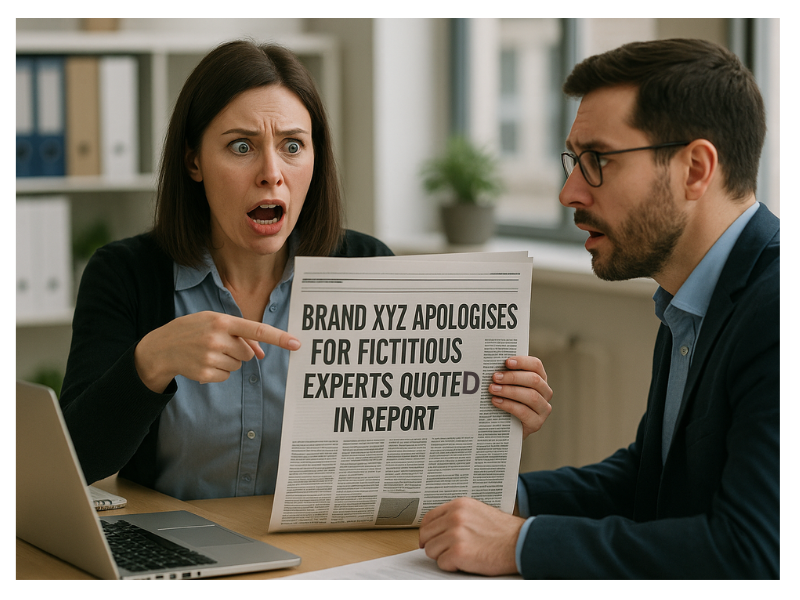There’s a massive elephant in the room when it comes to using gen AI to create content, and it’s sitting smack bang in the way of marketing teams trying to use it effectively.
In the joy of watching an article appear line by line, a lot of marketers overlook or even just don’t realise a hugely inconvenient truth – gen AI can make things up.
And the consequences can be alarming.
Just ask the lawyer who found this out the hard way, presenting fake case citations in submissions to the court. Or the consultancy that had to pay back some of its fee for a report apparently littered with sources pulled from thin air. Or the newspapers that published a summer book list of titles that didn’t actually exist. The list goes on and on – and on.
Embarrassing? Sure. Costly? Yes. Avoidable? Absolutely.
The rise of gen AI illustrates just how important editorial oversight is to the content creation process. And it goes far beyond fixing clunky expression.
If you’re using gen AI to write content, and you don’t have an editor, you’re risking your audience losing trust, damage to your reputation and even financial repercussions.
Here’s why an editor is more essential now than ever.

Wait, is AI really lying to me?
What AI creators call hallucinations aren’t lies in the human sense. They happen because large language models don’t know actually ‘know’ anything, but rather predict what words are likely to come next, based on patterns in the data they were trained on.
If the model hasn’t ingested accurate, up-to-date information on a topic, or if it’s combining ideas out of context, it can make something up to fulfil a prompt.
Which brings up the other lurking danger – AI models are trained to maximise user satisfaction and please people. If it can’t find the statistics you’ve asked for? The AI will create some to give you what you want, unless you’ve worded your prompt in a way that minimises that risk. Researchers from Princeton University are characterising it as “machine bullshit”.
You might also find it does a similar thing if you ask it to summarise information from an authority source. For example, if you give it a report and ask for a summary of the key findings, unless your prompt is carefully worded, it can skew information to match what you’re looking for and why you want it, rather than just sticking to the facts.
The result usually reads convincingly on first look, but delve a little deeper, and what is presented with great confidence as fact is often just fiction.
Are the facts really the facts?
When it produces content, an AI tool can include incorrect statistics, outdated information, sources that don’t exist or entirely fabricated details that sound believable but aren’t true.
It can even make up quotes on your topic from real people who have been interviewed for other articles. This should send a shiver down the spine of anyone who has been responsible for hitting the ‘publish’ button!
Without an editor’s oversight, these sorts of errors can easily make it to publication, especially in busy teams where everyone is under pressure and not always reading content with a critical eye.

Why an editor is necessary
AI tools write quickly, and the copy can sound good on the surface, but AI can’t think critically.
Editors bring a level of necessary human judgment to the process, and the ability to question and verify information. They ensure content is both well-written and factually correct.
A good editor knows to do a sense check – looking for gaps or bias in an argument, sections that don’t flow logically and statements that don’t quite stack up.
They check sources, confirm that claims can be verified and that details align with known facts.
For instance, if an AI tool references a study or a statistic, the editor checks that the study exists, the numbers used in the content are correct, and the source is credible.
They also make sure sources aren’t too old, irrelevant or cherry-picked to suit a narrative.
Fact-checking is a crucial part of building trust with your audience, especially when the internet is being flooded with AI-generated content that varies wildly in quality.
Get things wrong, or take shortcuts with the truth, and they won’t continue to engage. And it could land you in hot water in other ways as well!
The basics of fact-checking AI content
At the minimum, a set of critical eyes should be looking at every piece of AI-generated content, and:
- Checking that facts and figures can be traced back to original, authority sources, and have been reported correctly.
- Considering the quality of sources, whether they are current, relevant or skewed to fit a particular viewpoint.
- Verifying claims are legitimate and can be backed up with evidence.
- Making sure content flows logically, and can be easily understood.
AI can certainly speed up content creation. But you also need an editor to help ensure what you’re producing is accurate, coherent and aligned with content goals and your brand.
Download our content review checklist for AI-generated content as a handy guide for checking everything is factually correct and fit to publish! (No sign up needed – instant access.)
Karen Davis
Karen is the Senior Editor at Article Writers Australia, and has a background in journalism, editing and marketing communications.






